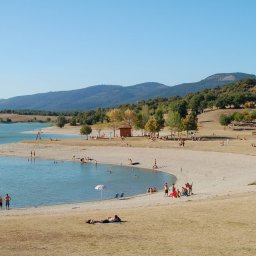Wheat never adapted to the wet climate of Bizkaia. Instead, millet was grown in fields and hills. From the 16th century onwards, New World products which changed food history were introduced in Europe such as cocoa, tomatoes, potatoes, beans and peppers. Corn came too. From the moment it landed on these shores, a culture of corn developed along the entire Cantabrian coast, providing a staple for the local population and fodder for their livestock
Festivals in Bizkaia have a typical, distinct aroma. A waft of toasting corn from a nearby stall always floats in the air. Characteristic and unique, the whiff of freshly-made talos – small corn flatbreads cooked on sizzling hot pans and used as wraps for chorizo or pork ribs – is unmistakable.
Nowadays, traditional talo flatbreads and corn bread can be found almost exclusively at festivals and popular public events such as the Lunes de Gernika and Santo Tomás fairs, as well as in some restaurants. However, until the 20th century, when wheat flour began to be transported in bulk, corn flour reigned supreme in Bizkaia.
Morokil and opil
In times gone by, local farmers would haul their golden harvests to the nearest of the many water-powered mills in the region, returning with a supply of the prized ground corn for home consumption.
There were three main ways corn featured in the traditional diet of Bizkaia. People made a delicious, sweet, hearty porridge called morokil with hot milk, corn flour and sugar. It was mixed with hot water and salt to make the deep, round opil bread. A ball of dough was pressed by hand into a round loaf about two fingers deep and slightly over a palm wide, and baked on a hot plate, iron-topped stove or in a griddle on a traditional iron tripod. Once the opil was ready, it kept for several days.
The talo flatbreads, however, were the most popular way it was consumed. Made with the same dough as the round opil loaves, the talos were flattened to a thickness of half a centimetre and toasted into crisp, enticingly aromatic pancakes, brittle on the outside and soft on the inside.

Talo with everything
Talo was eaten at breakfast, lunch and dinner, with cream, honey or jam. While it occasionally served as a meal in itself, often a frying pan full of chorizo, pork ribs, bacon and fried eggs was placed in the middle of the table so everyone could take whatever they fancied to fill their flatbreads.
“The water should be as hot as your hands can stand so it mixes properly with the flour. Knead it well, don’t leave any lumps or bubbles. Then take a small ball of dough – it should fit into the palm of your hand –, and lightly flour the board. Then start patting and let the music begin: tap-tap-a-tap-tap, tap-tap-a-tat”. This is how the method was described by an old hand in the art of making Basque flatbreads. The music is the rhythmic sound of the bakers’ hands as they flatten and turn the dough to produce a perfect pancake ready for cooking.
Wheat flour has dominated the market for a long time now and the traditional corn flatbreads have disappeared from everyday life. However, talos are still popular at Basque festivals where street food versions for making txistorra and chorizo wraps are commonplace. Basque flatbreads are slightly larger than Venezuelan arepas or Mexican tortillas. Corn in Bizkaia has come the full circle. A generous glass of Txakoli or cider pairs to perfection with these traditional Basque wraps. After all, the Basques have been doing it this way for centuries.

Bilbao hosts a multitudinous traditional market on December 21st, the feast of Santo Tomás
Honouring an age-old tradition, every December 21, the entire city turns into a huge, open-air market-fest in an event that never fails to enthral visitors who get sucked into a delirious, chaotic, aromatic vortex of market stalls, lively music, toasted corn, cackling capons, and fast-flowing, swooshing traditional cider.
According to the chronicles, the tenant-farmers who worked most of the arable land and livestock farms in Bizkaia paid rent on a yearly basis, travelling at the end of the year to Bilbao ––where most of the landlords resided – to hand over the cash. The farmers took advantage of the day in Bilbao to set up a market where they could sell the winter produce that was destined to grace the table at Christmas. The festive products included capons, snails, wild mushrooms, walnuts and hazelnuts, lamb, turkeys, apples, jams, pears, liqueurs, cabbages, cauliflowers, and pumpkins.
Once the rent was paid and the produce sold, the country folk would relax and have some fun before catching the train, tram, carriage or coach home. Nowadays, the event is so popular that the whole city comes to standstill on the day of the market. All the buses, trains, and other means of transport struggle to cope as hordes of black-smocked, beret-clad revellers arrive for the Txistorra sausage, corn flatbreads, cider and Txakoli, for the accordions, tambourines and the dancing.
















